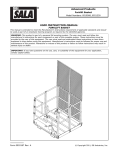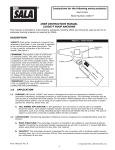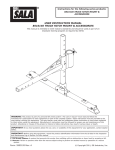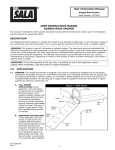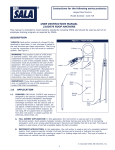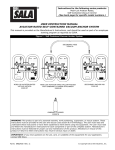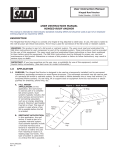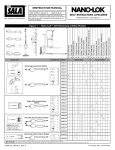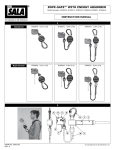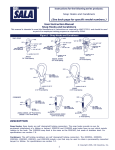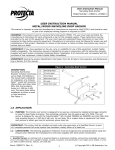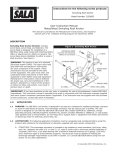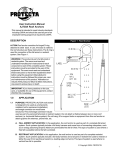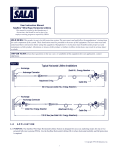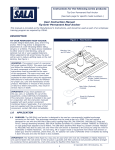Download User InstrUctIon ManUal 2103673 Roof Anchor and
Transcript
Instructions for the following series products: Roof Anchor Model Numbers: 2103673 User Instruction Manual 2103673 Roof Anchor and 7600511 Sayfline™ Horizontal Lifeline System This manual is intended to meet the Manufacturer’s Instructions as required by OSHA or other national and regulatory standards, and should be used as part of an employee training program as required by the identified agencies in Section 1.3. WARNING: This product is part of a personal fall arrest system1. The user or rescuer must read and follow the manufacturer’s instructions for each component or part of the complete system. These instructions must be provided to the user utilizing this equipment. The user must read and understand these instructions or have them explained to them before using this equipment. Manufacturer’s instructions must be followed for proper use and maintenance of this product. Alterations or misuse of this product or failure to follow instructions may result in serious injury or death. IMPORTANT: If you have questions about the use, care, or suitability of this equipment for your application, contact Capital Safety. IMPORTANT: Before using this equipment, record the product identification information from the ID label in the Inspection and Maintenance Log in Section 9 of this manual. DESCRIPTION: 2103673: Roof anchor consists of a cadmium plated forged O-ring, 9/32-inch alloy chain, and 3-inch wide rubber belt attached to a steel base. In use, the steel base is attached to the roof structure per these instructions. The O-ring is used for connection of the fall arrest or restraint system. See Figure 1. 7611904: Sayfline Synthetic Horizontal Lifeline, 50 foot (15 m), includes two 2103673 Roof Anchors. No more than two users may be connected to the system at any time. See Figure 1. 7611907: Two user kit. Figure 1 1 2 3 4 5 6 7 10 1. Clamp Plate 2. Rivet 3. Labels 4. Side Plate 5. Stud 6. Chain 7 11 12 10 1 8 9 10 10 7. Roof Anchor 8. Horizontal Lifeline System 9. Rope Direction 10. O-Ring 11. Connector 12. Rope 11 10 3 1 Fall Arrest System: A system that prevents the worker from colliding with an obstruction or lower level by arresting a fall. Form 5902138 Rev: F © Copyright 2012, DB Industries, Inc. 1.0 APPLICATIONS 1.1PURPOSE: DBI/SALA’s 2103673 roof anchor is designed to be used as a temporarily installed (not for permanent installation) anchorage connector on wood frame structures. This anchorage connector may be used as part of a personal fall arrest or restraint system. The 2103673 roof anchor may be used as an anchorage connector to the DBI/SALA Sayfline Synthetic Horizontal Lifeline System. See Figure 2 for application illustration. Do not hang, lift, or support tools or equipment from this roof anchor or attach guy lines for antennas, phone lines, etc A. FALL ARREST APPLICATION: In this application, the roof anchor is used as part of a complete fall arrest system. Such systems typically include a full body harness, and some form of connecting subsystem, such as an energy absorbing lanyard. Maximum permissible free fall is 6 feet (1.8 m). This type of system is used where a free fall is possible before the fall is arrested. B. RESTRAINT APPLICATION: In this application, the roof anchor is used as part of a complete restraint system. Such systems typically include a full body harness and a lanyard or restraint line used to restrain or tether the user from reaching a hazard (example leading edge roof work). This type of system is used where no vertical free fall is possible. Figure 2 2103673 Roof Anchor 3,600 lbs. (1,633 kg) Load (or 5,000 lbs. (2,268 kg) without certificate) 3,600 lbs. (1,633 kg)Load (or 5,000 lbs. (2,268 kg) without certificate) Sayfline HLL System 3,600 lbs. (1,633 kg)Load (or 5,000 lbs. (2,268 kg) without certificate) 2103673 Roof Anchor 3,600 lbs. (1,633 kg) Load (or 5,000 lbs. (2,268 kg) without certificate) Personal Fall Arrest System 3,600 lbs. (1,633 kg) Load (or 5,000 lbs. (2,268 kg) without certificate) 3,600 lbs. (1,633 kg) Load (or 5,000 lbs. (2,268 kg) without certificate) The roof structure must be capable of supporting a minimum of 3,600 lbs. (1,633 kg) in the load directions shown. Counter Weight 1.2LIMITATIONS: The following application limitations must be recognized and considered before using this product: A. ROOF STRUCTURE: This anchorage connector (2103673) is intended to be installed on wood framed roof structures capable of meeting the anchorage strength requirements as set forth in section 2.4. Consult DBI/SALA before using these roof anchors on any other roof materials. B.CAPACITY: This anchorage connector is designed for use by persons with a combined weight (person, clothing, tools, etc.) of no more than 310 lbs (141 kg). Only one personal protective system may be connected to the roof anchor (2103673) at any time. DBI/SALA Sayfline Synthetic Horizontal Lifeline Systems connected to the 2103673 roof anchor are rated for two users. C. PERSONAL FALL ARREST SYSTEM (PFAS): PFAS’s selected for use with this roof anchor must meet the system performance and other criteria as stated in section 3.2. D. FREE FALL: Personal fall arrest systems used with these roof anchors must be rigged in such a way as to limit the free fall to a maximum of 6 feet (1.8 m) (Reference ANSI Z359.1). See associated connecting subsystem manufacturer’s instructions for further information. 2 E. FALL CLEARANCE: Make certain that enough clearance exists in your fall path to prevent striking an object. The amount of clearance needed is dependent upon the type of connecting subsystem used (energy absorbing lanyard, self retracting lifeline, etc.), and the anchorage location. Refer to manufacturer’s instructions of the connecting subsystem or component for more information on fall clearance. F. RESTRAINT SYSTEMS: Restraint systems selected for use with this roof anchor must meet the requirements given in section 3.2. G.CORROSION: Use near sea water or other corrosive environments may require more frequent inspections or servicing (replacement) to assure corrosion damage is not affecting the performance of the product. H. CHEMICAL HAZARDS: Solutions containing acids, alkali, or other caustic chemicals, especially at elevated temperatures may cause damage to this equipment. Consult DBI/SALA if doubt exists concerning installing this equipment where chemical hazards are present. I. ELECTRICAL HAZARDS: Do not install roof anchors where they or the user may come into contact with electrical power lines. J.TRAINING: This equipment is intended to be installed and used by persons who have been properly trained in its correct application and use. 1.3 STANDARDS: Refer to national consensus (including ANSI Z359.1), applicable local, state, and federal (OSHA) requirements governing this equipment for more information on anchorage connectors, and associated system components. 2.0 SYSTEM REQUIREMENTS 2.1 COMPATIBILITY OF COMPONENTS: DBI/Sala is designed for use with DBI/Sala approved components and subsystems only. Substitutions or replacements made with non-approved components or subsystems may jeopardize compatibility of equipment and may effect the safety and reliability of the complete system. 2.2 COMPATIBILITY OF CONNECTORS: Connectors are considered to be compatible with connecting elements when they have been designed to work together in such a way that their sizes and shapes do not cause their gate mechanisms to inadvertently open regardless of how they become oriented. Contact DBI/ SALA if you have any questions about compatibility. Connectors (hooks, carabiners, and D-rings) must be capable of supporting at least 5,000 lbs. (22.2kN). Connectors must be compatible with the anchorage or other system components. Do not use equipment that is not compatible. Non-compatible connectors may unintentionally disengage. See Figure 3. Connectors must be compatible in size, shape, and strength. Self locking snap hooks and carabiners are required by ANSI Z359.1 and OSHA. Figure 3 - Unintentional Disengagement (Rollout) If the connecting element to which a snap hook (shown) or carabiner attaches is undersized or irregular in shape, a situation could occur where the connecting element applies a force to the gate of the snap hook or carabiner. This force may cause the gate (of either a self-locking or a non-locking snap hook) to open which will allow the snap hook or carabiner to disengage from the connecting point. Small ring or other noncompatibly shaped element 1.Force is applied to the snap hook. 2. The gate presses against the connecting ring 3 3. The gate opens allowing the snap hook to slip off 2.3 MAKING CONNECTIONS: Only use self-locking snap hooks and carabiners with this equipment. Only use connectors that are suitable to each application. Ensure all connections are compatible in size, shape, and strength. Do not use equipment that is not compatible. Ensure all connectors are fully closed and locked. DBI/Sala connectors (snap hooks and carabiners) are designed to be used only as specified in each product’s user instructions. See Figure 4 for inappropriate connections. Capital Safety snap hooks and carabiners should not be connected: A. To a D-ring to which another connector is attached. B. In a manner that would result in a load on the snap hook or carabiner gate. NOTE: Large throat opening snap hooks should not be connected to standard size D-rings or similar objects which will result in a load on the gate if the hook or D-ring twists or rotates. Large throat snap hooks are designed for use on fixed structural elements such as rebar or cross members that are not shaped in a way that can capture the gate of the hook. C. In a false engagement where features that protrude from the snap hook or carabiner catch on the anchor and, without visual confirmation, seems to be fully engaged to the anchor point. D. To each other. E. Directly to webbing or rope Lanyard or tieback (unless the manufacturer’s instructions for both the Lanyard and connector specifically allows such a connection). F. To any object which is shaped or dimensioned such that the snap hook or carabiner will not close and lock, or that roll-out could occur. G. In a manner that does not allow the connector to align with the fall arrest device (i.e., lanyard) while under load. Figure 4 - Inappropriate Connections 2.4 ANCHORAGE STRENGTH: Depending on the application, the anchorage to which the roof anchor is installed must meet minimum strengths as follows: FALL ARREST: Roof anchors installed for fall arrest applications must be attached to a roof member capable of sustaining static loads in the direction(s) permitted by the PFAS when in use of at least: (A) 3,600 lbs. (16kN) when certification exists (Reference ANSI Z359.1 for certification definition), or (B) 5,000 lbs. (22.2kN) in the absence of certification. When more than one roof anchor is installed to a roof structure, the strengths given in (A) or (B) above must be met at each roof anchor installation point independently. EXAMPLE: If two roof anchors are installed onto a roof structure, each anchor location must be independently capable of supporting 5,000 lbs. (or 3,600 lbs. with certification). See Figure 2. RESTRAINT: Roof anchors installed for restraint applications must be attached to a roof member capable of sustaining a static load of at least 3,000 lbs (1,361 kg). applied in any direction permitted by the restraint system when in use. Each roof anchor installation must independently be capable of sustaining this load. 4 3.0 OPERATION AND USAGE: WARNING: Do not alter or intentionally misuse this equipment, your safety may depend on it. Consult DBI/ SALA when using this equipment in combination with components or subsystems other than those described in this manual. Some subsystem and component combinations may interfere with the proper operation of this equipment. Use caution when using this equipment around sharp edges, chemical hazards, moving machinery and electrical hazards. WARNING: Consult your doctor if there is any reason to doubt your fitness to safely absorb the shock from a fall arrest. Age and fitness seriously affect a workers ability to withstand falls. Pregnant women or minors must not use DBI/SALA Roof Anchors. 3.1 BEFORE USE of this equipment, carefully inspect it to assure that it is in serviceable condition. Check for missing or damaged parts, see Figure 1. The steel side plates should be flat and free of corrosion. Rivets should be tight and securely clinched. Check for installation of lag screws (6) or nails (12). Check for damage to the chain and O-Ring. Refer to section 5.0 for further inspection details. Do not use if inspection reveals an unsafe condition. NOTE: The 2103673 is designed as a removable anchor. It is intended to be installed, used, and removed for future installation and use. 3.2PLAN your fall arrest or restraint system before starting your work. Take into consideration factors affecting your safety at any time during use. The following list gives some important points you must consider when planning your system: A.ANCHORAGE: Select an anchorage point that is rigid and capable of supporting the required loads. See section 2.4 and Figure 2. Locate roof anchor in accordance with section 3.3. Figure 5 - Swing Falls B. FREE FALL: Personal fall arrest systems must be rigged to limit any free fall to a maximum of 6 feet (OSHA and ANSI Z359.1), restraint systems must be rigged such that no vertical free fall is possible. Avoid working above your anchorage level since an increased free fall distance will result. C. PERSONAL FALL ARREST SYSTEM REQUIREMENTS: PFAS’s used with this roof anchor must meet applicable OSHA, state, federal and ANSI requirements. PFAS’s incorporating a full body harness must be capable of arresting a workers fall with a maximum arresting force of no greater than 1,800 lbs (816 kg). (900 lbs. [408 kg] maximum arresting force where used with a Sayfline Synthetic Horizontal Lifeline System) and limit the free fall distance to 6 feet or less. The deceleration distance for a PFAS must be 42 inches (1.1 m) or less. Reference ANSI Z359.1 and OSHA requirements. Gable End Swing Fall D. RESTRAINT SYSTEMS: Restraint systems must meet applicable state and federal requirements. E. FALL CLEARANCE: Should a fall occur, there must be sufficient clearance in the fall area to arrest the fall before striking the ground or other object. The actual clearance required is dependent upon the type of fall arrester connecting subsystem used (energy absorbing lanyard, self retracting lifeline, horizontal lifeline system, etc.). Refer to manufacturer’s instructions for fall clearance information. F. SWING FALLS: Swing falls occur when the anchor location is not directly above the point where a fall occurs. The force of striking an object while swinging can be great and may cause serious injury. Swing falls can be minimized by working as directly below the anchorage as possible. It is acceptable to captivate a lifeline (i.e. rope grab system) to an anchorage close to the work area with a carabiner, see Figure 5. Do not captivate the lifeline of a self retracting lifeline as this may affect the performance of its internal braking. 5 Swing Fall Hazard Roof Peak R O O F E D G E Lifeline Roof Anchor Carabiner Rope Grab Roof Edge Captivating a Lifeline G. SHARP EDGES: Avoid working where the connecting subsystem (i.e. shock absorbing lanyard, self retracting lifeline, full body harness, etc.) or other system components will be in contact with, or abrade against unprotected sharp edges. Do not loop lanyards around small diameter structural members. If working with this equipment near sharp edges is unavoidable, protection against cutting must be provided by using a heavy pad or other means over the exposed sharp edge. H. RESCUE: Should a fall occur, the user (employer) must have a rescue plan and the means at hand to implement it. I. AFTER A FALL: Any equipment which has been subjected to the forces of arresting a fall must be removed from service immediately and destroyed or contact factory authorized service center for repair. 3.3 INSTALLATION REQUIREMENTS A. ROOF ANCHOR SITE PLAN: Before starting the roof construction, a site plan should establish where the roof anchors will be installed and when, during the construction process, they may be used. The following are guidelines on locating roof anchors: • The roof anchor should be located at the roof peak (when possible) and at least 6 feet (1.8 m) from any exposed roof edge. On very small roof areas, locate the roof anchor as far from the roof edge as possible. • Do not install roof anchors on unsupported roof structure such as eve or gable overhangs. • Do not install roof anchors on facia boards. • Roof anchors should be installed at 8 foot (2.4 m) spacing along the roof peak. • Hip roofs require a roof anchor on each hip face. • On long low pitched roofs, multiple roof anchors should be installed along gable ends (6 feet [1.8 m] from the edge) to reduce swing fall hazards. Figure 6 shows typical roof anchor locations for various roof configurations. Figure 6 - Roof Anchor Locations At least one anchor on hip roof B. ROOF FRAMING: Roof framing members to which the roof anchors are attached must be in good condition. Members must be free of splits, cracks, large knots or other defects that may weaken the member. Do not attach the roof anchor to rotted or deteriorated wood. WARNING: Roof anchors installed onto a rafter or truss which previously had a roof anchor nailed or screwed in place must be positioned to assure the new nails will not use any of the existing holes. C. ROOF ANCHOR INSTALLATION: Roof anchors must be located on the roof in accordance with the previously discussed site plan. Site work rules must be followed regarding when an installed anchor is ready for use (i.e. properly braced, etc.). ATTACHING THE ROOF ANCHOR: Adjust the side plates to match the surface it will be mounted on, either a roof peak or a flat surface. Position the anchor on the roof so the 6 screw holes along the center of the side plates are over a roof (framing) member (2x4 minimum). See Figure 7. Then, push down to minimize any gap between the anchor and the sheathing and install twelve 16d nails or 6 lag screws (3/16-inch or smaller pilot holes may be drilled for easier installation of lag screws). Use only 1/4-inch x 2 1/2-inch or longer lag screws. See Figure 8. See section 5.0 for pre-use inspection. 6 WARNING: The lag screws or nails must go through the sheathing and into the roof member. If they do not, the anchor will not hold the rated loads and serious injury or death could occur (See Figure 8). Figure 7 - Roof Anchor Installation WARNING: Use only 16d nails or 1/4-inch x 2 1/2-inch or longer lag screws. IMPORTANT: If the 2103673 is installed over old shingles, make sure it is nailed or screwed into the roof member (rafter or truss). D. REMOVAL OF ROOF ANCHOR: Remove the 2103673 roof anchor prior to shingling the area with the anchor. To remove it, unscrew the lag screws or pull the nails and remove. The 2103673 is a removable roof anchor and is designed to be reinstalled following inspection per section 5.0. 3.4 MAKING CONNECTIONS: When using a hook to make a connection, be certain accidental disengagement (rollout) cannot occur. Roll-out occur when interference between a hook and the mating connector causes the hook’s gate or keeper to accidentally open and release. Self locking snap hooks or self locking and self closing gate carabiner must be used to reduce the possibility of roll-out when making connections. Do not use hooks or connectors that will not completely close over the object. Do not use non-locking hooks. Always follow the manufacturer’s instructions supplied with each system component. See Figure 9. Figure 8 - Roof Anchor Fasteners Roof Anchor Sheathing Rafter or Truss 1/4 x 2 1/2 Lag Screws 3.5 CONNECTING TO ROOF ANCHOR: Connection to the installed roof anchor may be made using a self locking snap hook or self locking and self closing carabiner only. Do not use a knot to connect a lifeline to the roof anchor. Do not pass a lanyard or lifeline through the roof anchor ring and hook back into lanyard or lifeline. When connecting, make sure connections are fully closed and locked. Figure 9 illustrates proper connection of typical fall arrest or restraint equipment to the roof anchor. When using an energy absorbing lanyard, connect the energy absorber “pack” end to the harness. When using a self retracting lifeline, make sure the device is properly positioned so that retraction is not hindered. Always protect the lifeline/lanyard from abrading against sharp or abrasive surfaces on the roof. Make sure all connections are compatible is size, shape and strength. Never connect more than one personal protective system to any single roof anchor at a time. WARNING: Read and follow manufacturer’s instructions for associated equipment (i.e. full body harness, shock absorbing lanyard, self retracting lifeline, etc.) used in your personal fall arrest system. IMPORTANT: For special (custom) versions of this product, follow the instructions herein. If enclosed, see attached supplement for additional instructions to be followed when using a customized product. 7 Figure 9 - Connections Self Retracting Lifeline Full Body Harness Rope Grab Lifeline Roof Anchor Roof Anchor Lanyard Energy Absorber Roof Anchor Synthetic HLL System Roof Anchor Lanyard Energy Absorber 4.0TRAINING: 4.1 It is the responsibility of all users of this equipment to understand these instructions, and to be trained in the correct installation, use, and maintenance of this equipment. All users must be aware of the consequences of improper installation or use of this equipment. This user manual is not a substitute for a comprehensive training program. Training must be provided on a periodic basis to ensure proficiency of the users. WARNING: Consult your doctor if there is reason to doubt your fitness to safely absorb the shock from a fall arrest. Age and fitness seriously affect a worker’s ability to withstand falls. Pregnant women or minors must not use this equipment. IMPORTANT: Training must be conducted without exposing the trainee to a fall hazard. Training should be repeated on a periodic basis. 5.0INSPECTION: 5.1FREQUENCY: Before use, visually inspect per steps listed in section 5.2 and 5.3. IMPORTANT: If this equipment has been subjected to forces resulting from the arrest of a fall, it must be immediately removed from service and destroyed. See section 5.2. 5.2 INSPECTION STEPS BEFORE USE: Step 1. Inspect the Roof Anchor for physical damage. Look carefully for any signs of cracks, dents or deformities in the metal. Check for bending, the roof anchor side plates should be flat. Rivets should be securely attached and fully clinched (not pulling through hole). Inspect chain and O-Ring for damage. 8 Step 2. Inspect the Roof Anchor for signs of excessive corrosion. Step 3. Ensure the condition of the roof will support the Roof Anchor loads, see section 2.3. An anchor connected to rotted or deteriorated wood should not be used. Step 4. Ensure the Roof Anchor is still securely attached. If loose, do not use. Step 5. Inspect each system component or subsystem per associated manufacturer’s instructions. Step 6. Record the inspection date and results in the inspection log. See section 9.0. 5.3 If inspection reveals a defective condition, remove unit from service immediately and destroy or contact factory authorized service center for repair. NOTE: Only DBI/SALA or parties authorized in writing may make repairs to this equipment. 6.0 MAINTENANCE - SERVICING - STORAGE: 6.1 No scheduled maintenance is required. If you have any questions concerning the condition of your Roof Anchor, or have any doubt about putting it into service, contact DBI/SALA immediately. 6.2 Additional maintenance and servicing procedures (i.e. replacement parts) must be completed by a factory authorized service center. Authorization must be in writing. 6.3 Unused roof anchors must be stored in a clean dry location. 7.0SPECIFICATIONS: Material: Forged alloy O-ring, 9/32-inch alloy chain, 3-inch wide rubber conveyor belt and carbon steel side plate. Strength of installed roof anchor in directions shown: 5,000 lbs. (2,268 kg) 3,000 lbs (1,361 kg) Weight: 4.4 lbs. (2 kg) Size: 1/4 in. x 3 in. x 25 in. (6 mm x 7.6 cm x 63.5 cm) Capacity: 310 lbs. (141 kg) (one person) 9 8.0LABELING: 8.1 These labels must be securely attached to the Sayfline™ HLL, and be fully legible. See Figure 1. Warning Label, Synthetic HLL System Clearance Label, Synthetic HLL System ID Label, Synthetic HLL System Inspection Log Label Rope Tightener Label 8.2 This label must be attached to the Roof Anchor and be fully legible: 10 9.0 INSPECTION AND MAINTENANCE LOG SERIAL NUMBER: MODEL NUMBER: DATE PURCHASED: INSPECTION DATE DATE OF FIRST USE: INSPECTION ITEMS NOTED CORRECTIVE ACTION Approved By: Approved By: Approved By: Approved By: Approved By: Approved By: Approved By: Approved By: Approved By: Approved By: Approved By: Approved By: Approved By: Approved By: Approved By: Approved By: Approved By: Approved By: Approved By: 11 MAINTENANCE PERFORMED LIMITED LIFETIME WARRANTY Warranty to End User: D B Industries, Inc., dba CAPITAL SAFETY USA (“CAPITAL SAFETY”) warrants to the original end user (“End User”) that its products are free from defects in materials and workmanship under normal use and service. This warranty extends for the lifetime of the product from the date the product is purchased by the End User, in new and unused condition, from a CAPITAL SAFETY authorized distributor. CAPITAL SAFETY’S entire liability to End User and End User’s exclusive remedy under this warranty is limited to the repair or replacement in kind of any defective product within its lifetime (as CAPITAL SAFETY in its sole discretion determines and deems appropriate). No oral or written information or advice given by CAPITAL SAFETY, its distributors, directors, officers, agents or employees shall create any different or additional warranties or in any way increase the scope of this warranty. CAPITAL SAFETY will not accept liability for defects that are the result of product abuse, misuse, alteration or modification, or for defects that are due to a failure to install, maintain, or use the product in accordance with the manufacturer’s instructions. CAPITAL SAFETY’S WARRANTY APPLIES ONLY TO THE END USER. THIS WARRANTY IS THE ONLY WARRANTY APPLICABLE TO OUR PRODUCTS AND IS IN LIEU OF ALL OTHER WARRANTIES AND LIABILITIES, EXPRESSED OR IMPLIED. CAPITAL SAFETY EXPRESSLY EXCLUDES AND DISCLAIMS ANY IMPLIED WARRANTIES OF MERCHANTABILITY OR FITNESS FOR A PARTICULAR PURPOSE, AND SHALL NOT BE LIABLE FOR INCIDENTAL, PUNITIVE OR CONSEQUENTIAL DAMAGES OF ANY NATURE, INCLUDING WITHOUT LIMITATION, LOST PROFITS, REVENUES, OR PRODUCTIVITY, OR FOR BODILY INJURY OR DEATH OR LOSS OR DAMAGE TO PROPERTY, UNDER ANY THEORY OF LIABILITY, INCLUDING WITHOUT LIMITATION, CONTRACT, WARRANTY, STRICT LIABILITY, TORT (INCLUDING NEGLIGENCE) OR OTHER LEGAL OR EQUITABLE THEORY. A Capital Safety Company CSG USA & Latin America 3833 SALA Way Red Wing, MN 55066-5005 Toll Free: 800.328.6146 Phone: 651.388.8282 Fax: 651.388.5065 [email protected] CSG Canada 260 Export Boulevard Mississauga, ON L5S 1Y9 Phone: 905.795.9333 Toll-Free: 800.387.7484 Fax: 888.387.7484 [email protected] CSG Northern Europe Unit 7 Christleton Court Manor Park Runcorn Cheshire, WA7 1ST Phone: + 44 (0)1928 571324 Fax: + 44 (0)1928 571325 [email protected] CSG EMEA (Europe, Middle East, Africa) Le Broc Center Z.I. 1ère Avenue 5600 M B.P. 15 06511 Carros Le Broc Cedex France Phone: + 33 4 97 10 00 10 Fax: + 33 4 93 08 79 70 [email protected] CSG Australia & New Zealand 95 Derby Street Silverwater Sydney NSW 2128 AUSTRALIA Phone: +(61) 2 8753 7600 Toll-Free : 1 800 245 002 (AUS) Toll-Free : 0800 212 505 (NZ) Fax: +(61) 2 87853 7603 [email protected] CSG Asia Singapore: 16S, Enterprise Road Singapore 627666 Phone: +65 - 65587758 Fax: +65 - 65587058 [email protected] www.capitalsafety.com I S O 9001 Certificate No. FM 39709 Shanghai: Rm 1406, China Venturetech Plaza 819 Nan Jing Xi Rd, Shanghai 200041, P R China Phone: +86 21 62539050 Fax: +86 21 62539060












